Bayer R.G. Mechanical Wear Fundamentals and Testing, Revised and Expanded
Подождите немного. Документ загружается.

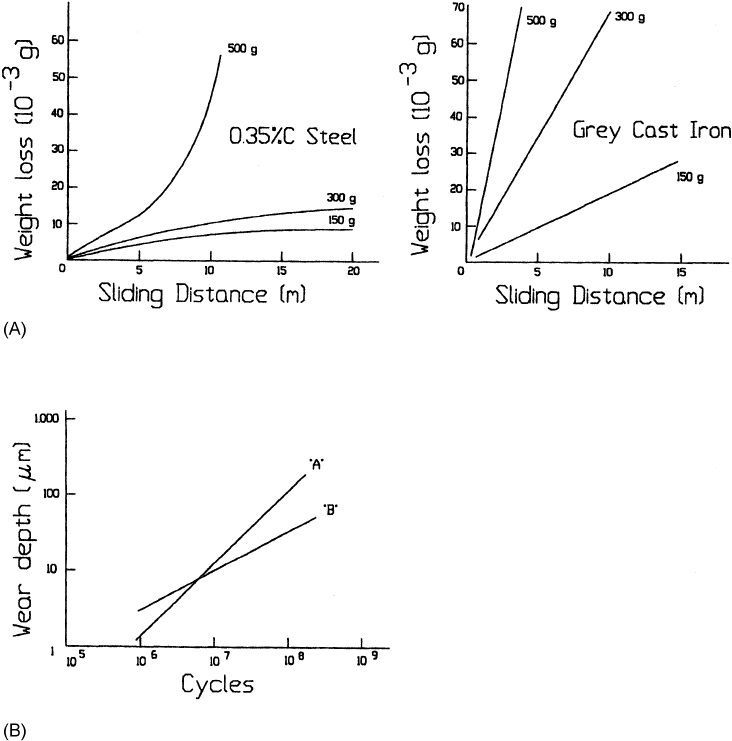
where wear rates, wear coefficients, and mechanisms are likely to be studied. How-
ever, tests have to be of sufficient duration that all run-in and break-in behavior have
ceased.
In some wear situations, it is also possible that initial wear rates might be lower than
longer-term wear rates. This is generally the result of initial surface films or layers, which
act as lubricants and are gradually worn away. Such an effect is more common with un-
lubricated tribosystems than with lubricated tribosystems.
The effect of break-in and run-in illustrates another general aspect of wear behavior
that needs to be recognized. This is that the immediate or current wear behavior can be
influenced by earlier wear. In addition to the effect of break-in and run-in on longer-term
wear, the influence of wear debris is another illustration. Since wear debris can be trapped
in the wear region and cause further wear, its charact eristics can influence current wear
Figure 4.3 The influence of materials on wear in different situations. ‘‘A’’, abrasion of borided
materials; ‘‘B’’, lubricated sliding against 52100 steel; ‘‘C’’, Au–Au sliding; ‘‘D’’, solid particle ero-
sion. (‘‘A’’ from Ref. 9; ‘‘B’’ from Ref. 4; ‘‘C’’ from Ref. 101; and ‘‘D’’ from Ref. 9.).
Copyright 2004 by Marcel Dekker, Inc. All Rights Reserved.
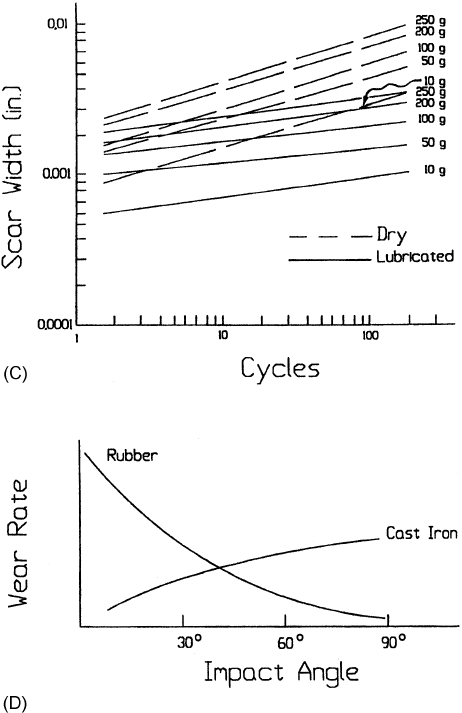
behavior, while the prior wear behavior will determine the characteristics of the debris.
For example, the occurrence of initial coarse debris as the result of a momentary overload
condition or lubrication failure might inhibit the development of a mild, stable wear region
that is more typical of the wear system. The momentary introduction of a small amount of
abrasive into a system might trigger such a sequence as well.
Wear behavior is frequently characterized as being mild or severe (14,16,22–25).
Mild wear is generally used to describe wear situations in which the wear rate is relatively
small and the features of the wear scar are fine. Severe wear, on the other hand, is asso-
ciated with higher wear rates and scars with coarser features. For reference, Fig. 4.10
shows wear scars that are representative of mild and severe wear. Most mate rials can
exhibit both mild and severe behavior, depending on the specifics of the wear system in
which they are used. Frequently, the transition from mild to severe are abrupt. Figure 4.11
illustrates such a transition for polymers. Mild wear behavior is generally required for
engineering applications. In cases where severe wear behavior must be accepted, main-
tenance is high and lives are short.
Figure 4.3 (continued )
Copyright 2004 by Marcel Dekker, Inc. All Rights Reserved.
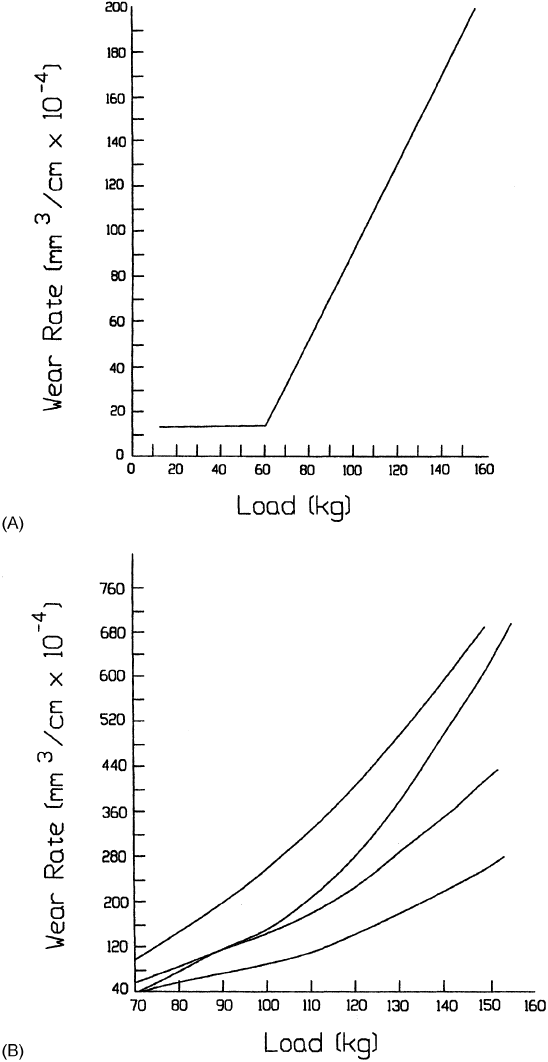
Figure 4.4 The effect of load. ‘‘A’’, ‘‘B’’, and ‘‘C’’, unlubricated sliding against steel; ‘‘D’’, general
sliding and rolling. (‘‘A’’ and ‘‘B’’ from Ref. 5; ‘‘C’’ from Ref. 9.)
Copyright 2004 by Marcel Dekker, Inc. All Rights Reserved.
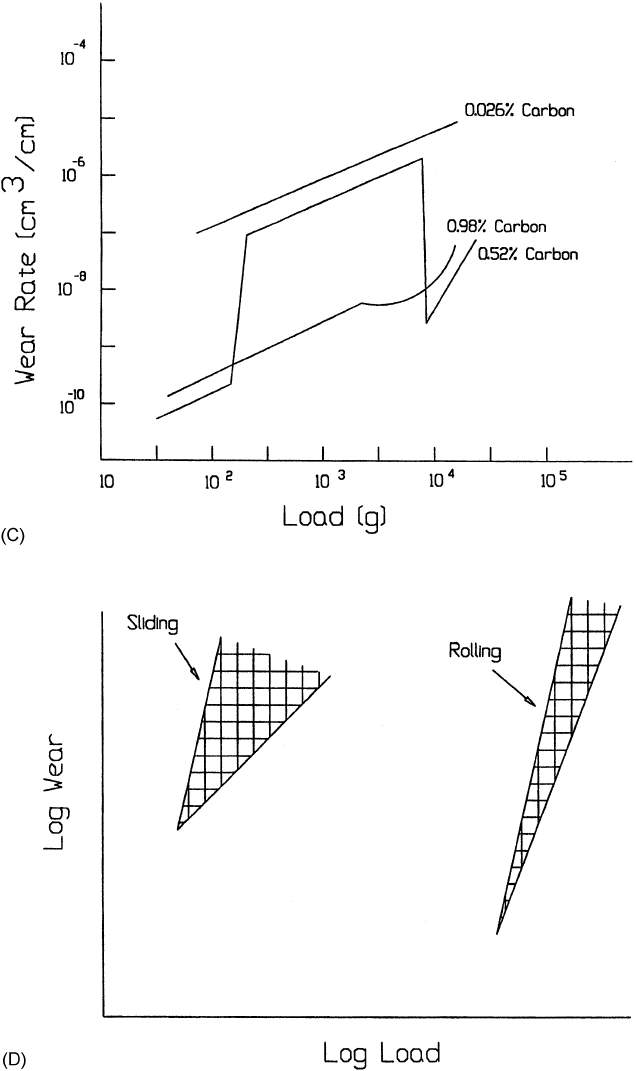
Figure 4.4 (continued )
Copyright 2004 by Marcel Dekker, Inc. All Rights Reserved.
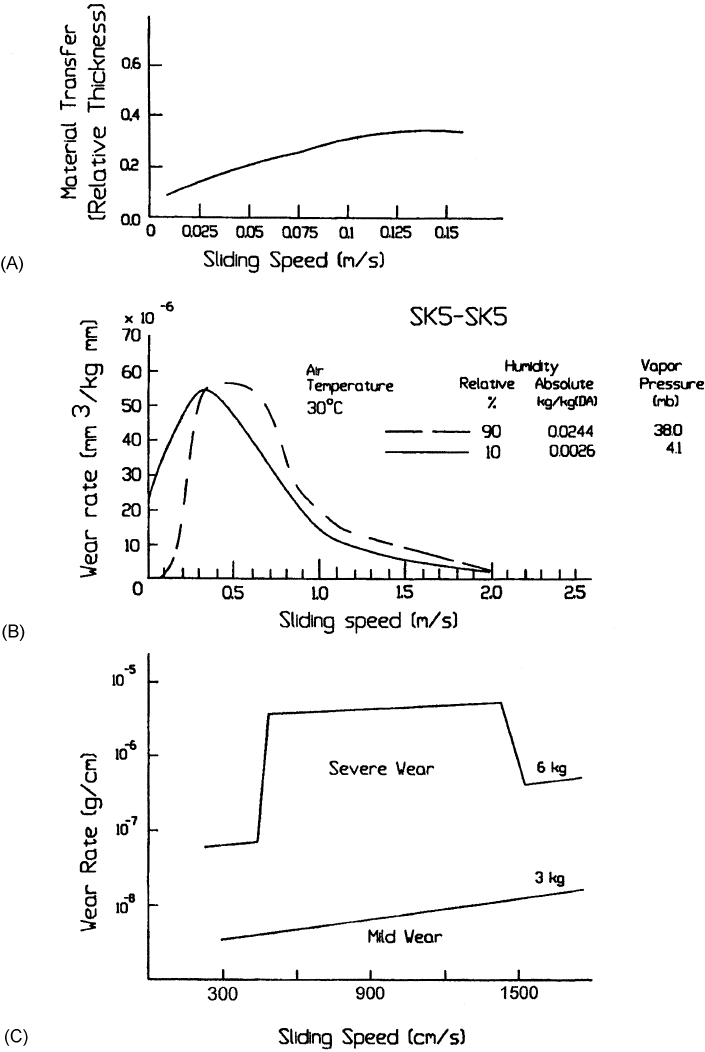
Figure 4.5 The effect of speed. ‘‘A’’, PTFE sliding against polyethylene; ‘‘B’’, unlubricated steel
against steel; ‘‘C’’, unlubricated iron against steel. (‘‘A’’ from Ref. 6; ‘‘B’’ from Ref. 13; ‘‘C’’ from
Ref. 9. ‘‘A’’ and ‘‘B’’ reprinted with permission from ASME. ‘‘C’’ reprinted with permission from
ASM International.)
Copyright 2004 by Marcel Dekker, Inc. All Rights Reserved.
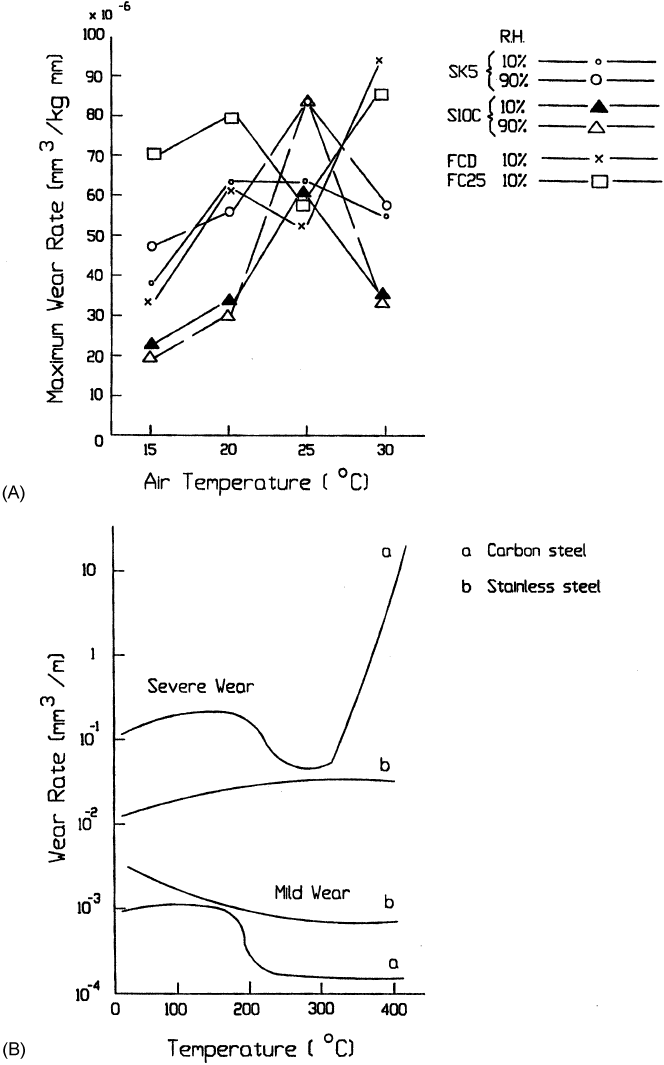
Figure 4.6 The effect of ambient temperature. ‘‘A’’ and ‘‘B’’ show the effect in several cases of
unlubricated sliding between metal interfaces. (‘‘A’’ from Ref. 13; ‘‘B’’ from Ref. 14.)
Copyright 2004 by Marcel Dekker, Inc. All Rights Reserved.
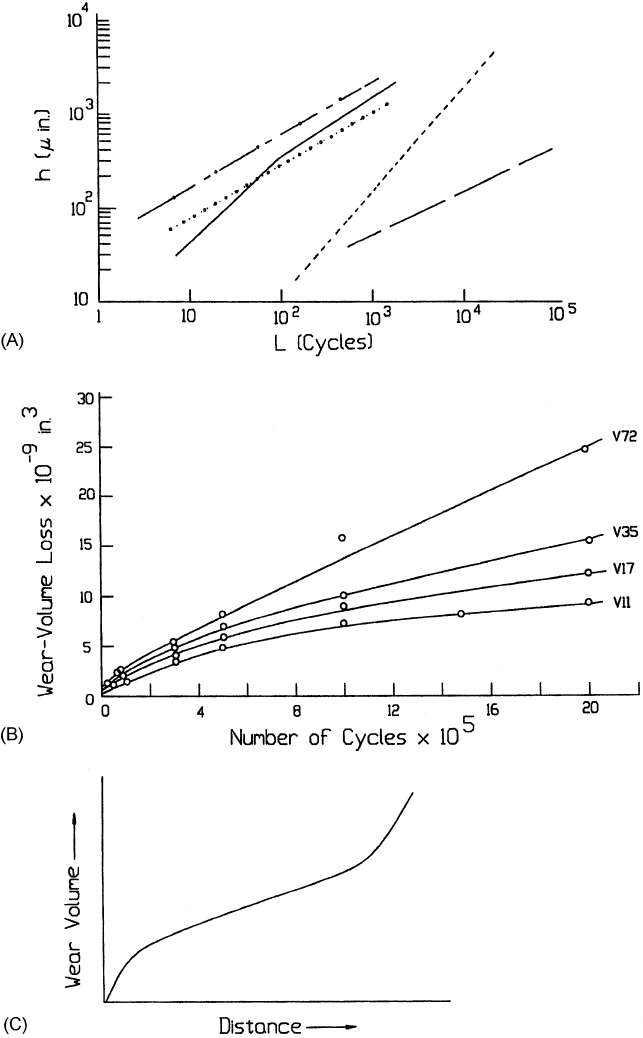
Figure 4.7 Wear behavior as a function of duration. ‘‘A’’, ceramic=steel sliding; ‘‘B’’, steel=steel
sliding; ‘‘C’’, block-on-ring tests; ‘‘D’’, polymer composite=cermet sliding; ‘‘E’’, impact; ‘‘F’’, ero-
sion; ‘‘G’’ , slurry abrasion. (‘‘A’’ from Ref. 77; ‘‘B’’ from Ref. 10; ‘‘C’’ from Ref. 15; ‘‘D’’ from
Ref. 7; ‘‘E’’ from Ref. 78; ‘‘F’’ from Ref. 50; and ‘‘G’’ from Ref. 79.)
Copyright 2004 by Marcel Dekker, Inc. All Rights Reserved.
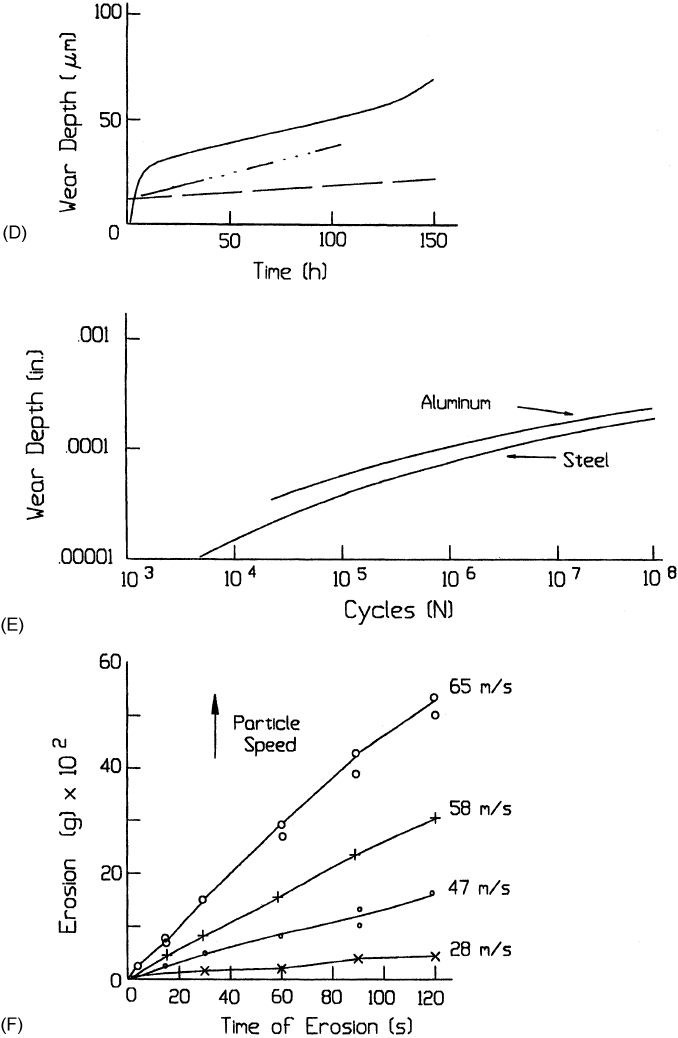
Figure 4.7 (continued )
Copyright 2004 by Marcel Dekker, Inc. All Rights Reserved.
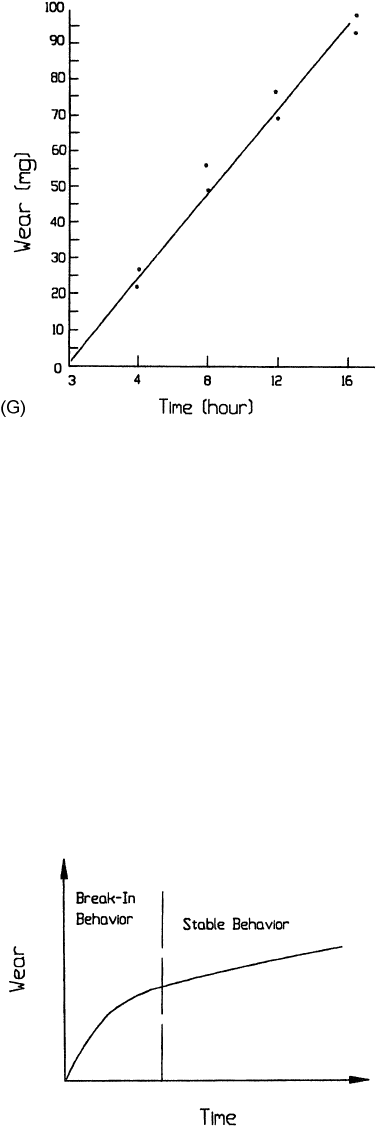
There are several factors, which contribute to the general complex and varied
nature of wear behavior. One factor is the number of basic wear mechanisms.
Depending on the mechanism and the parameter considered, there are a mixture of lin-
ear and nonlinear relationships possible, as well as transitions in mechanisms. Conse-
quently, a wide variety of behaviors is to be expected for different wear situations.
A second factor is that wear mechanisms are not mutually exclusive and can interact
in different ways. A final contributor to complex wear behavior is the modifications
that take place on the wearing surfaces. As is obvious from the examination of worn
surfaces, wear modifies the surface in addition to removing the material. Modifications
to the topography are generally immediately apparent (e.g., scratches, pits, smearing,
etc.). While less obvious, the composition of the surfaces can also be modified, as well
as the mechanical properties of the surfaces. These changes to tribosurfaces are signifi-
cant factors in the break-in behavior referred to previously. As a generalization, these
Figure 4.7 (continued )
Figure 4.8 Wear curve showing the effect of break-in behavior.
Copyright 2004 by Marcel Dekker, Inc. All Rights Reserved.
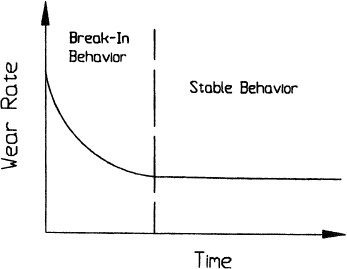
surface modifications can be influenced by a wide variety of parameters associated with
the wearing system (e.g., relative humidity, nature of the relative motion, active com-
ponents of a lubricant, etc.). Since the wear mechanisms are functions of the surface
parameters, the dependencies of surface modifications on this larger set of parameters
can result in more complex relationships for wear. In addition, since wear can influence
surface modifications, a compounding of effects can take place. Interactions and trends
with wear mechanisms, wear transitions, and modifications of tribosurfaces are
discussed in further detail in the following sections.
The complex nature and range of wear behavior possible can generally be simplified
and reduced to a practical level for engineering because of the limited range of tribosystem
parameters that need to be considered. However, the range of behavior shown in
Figs. 4.1–4.7, along with these observations regardi ng the many factors associated with
wear behavior, suggests the following. As an overview, it is appropriate to consider wear
behavior generally as nonlinear, with linear behavior possible under certa in conditions
and narrow ranges of parameters.
4.2. MECHANISM TRENDS
One factor that contributes to the complex nature of wear behavior is the possibility of
different wear mechanisms. Depending on the mechanism and the parameter considered,
there are a mixture of linear and nonlinear relationships possible, as well as transitions.
For example, the simple model for adhesive wear gives a linear-dependency on sliding,
while a model for fatigue wear gives a nonlinear dependency. In an abrasive wear situa-
tion, theory supports a transition in wear behavior when the abraded material becomes
harder than the abrasive. In addition, not all mechanisms depend on the same parameters
in the same way. For example, the model for corrosive wear indicates an explicit depen-
dency on sliding speed; the models for the other modes do not contain an explicit depen-
dency on speed. Conse quently, a wide variety of behaviors is to be expected for different
wear situations.
A contributing element to this complexity is that wear mechanisms are not mutually
exclusive. Frequently wear scar morphology indicates the simultaneous or parallel occur-
rence of more than one mechanism (16,26–29). An illustration of this is shown in Fig. 4.12.
In this sliding wear scar da mage features suggestive of both single-cycle deformation and
repeated-cycle deformation wear are present. The overall wear behavior of such a system
Figure 4.9 Wear rate behavior as a result of break-in behavior.
Copyright 2004 by Marcel Dekker, Inc. All Rights Reserved.
